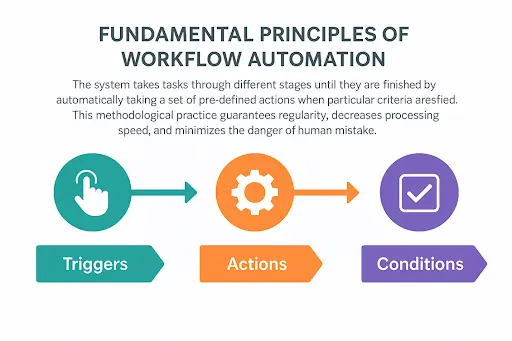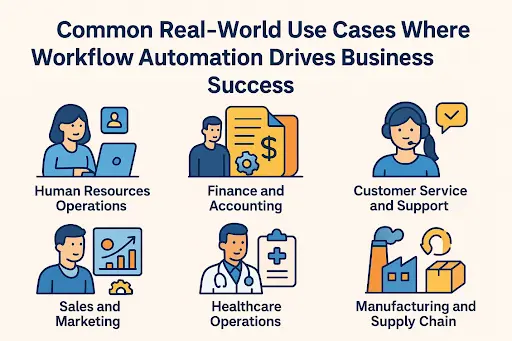Table of Contents
Workflow automation helps businesses cut costs, improve productivity, and simplify processes. Learn the key benefits, strategies, and real-world examples to successfully implement automation and drive efficiency across different operations.

The current business environment is rather dynamic, and companies are continuously attempting to seek ways of increasing efficiency and reducing operational costs. Workflow automation, especially marketing workflow automation, has turned out as the game-changer that enables businesses to automate common labor, save on human error, and invest the valuable resources in their strategic initiatives.
The use of automated workflows is giving multinational corporations in the industries big gains in productivity, reduction in costs, and employee satisfaction. This is the complete guide in regard to workflow automation, including the description of the fundamental concepts as well as the development of more advanced implementation strategies leading to a measurable business outcome.
What Is Workflow Automation and How Does It Work?
Workflow automation is the act of applying technology to accomplish routine business tasks and processes with a minimum of manual involvement. It is the process of designing, implementing, and automation business processes, using set rules and conditions.

The fundamental principles of workflow automation are a series of triggers, actions, and conditions. The system takes tasks through different stages until they are finished by automatically taking a set of pre-defined actions when particular criteria are satisfied. This methodological practice guarantees regularity, decreases processing speed, and minimizes the danger of human mistakes.
Exploring the Top Benefits of Workflow Automation
Workflow automation offers many benefits that have direct bottom-line alignment and operational efficiency to an organization.

Improved Productivity and Efficiency
Automated workflows remove time-intensive manual processes so that employees can concentrate on activities of higher value that involve creativity and strategy. The productivity gains occurring in organizations are usually 20-30 percent in the first year of implementation.
Significant Cost Reduction
By cutting down on the labor input needed to accomplish a task and minimizing error that results in the need to correct, workflow automation saves large amounts of money. A large number of businesses have documented ROI increases of 200-300% within 18 months of implementation.
Greater Accuracy and Consistency
Human error in a repetitive task can prove to be expensive and time-consuming to rectify. Automated workflows are important as they guarantee the presence of the commonly executed work based on the established standard, and the error rate is minimal as well as the overall quality of work is improved.
Greater Compliance and Audit Trails
Workflow automation tools keep log trails of every action, forming elaborate audit trails that facilitate compliance needs and regulatory reporting. This openness comes in especially handy in the highly regulated sectors.
Improved Employee Satisfaction
Employees would have more time to do meaningful work, which can utilize their skills and creativity since workflow automation would eliminate time-consuming and repetitive activities. This leads to higher job satisfaction and a reduction in turnover.
An automation workflow can easily be scaled to meet higher volumes without correspondingly higher staffing. They also give the flexibility to be able to adapt to the changing business needs and the market conditions at a very quick pace.
Common Real-World Use Cases Where Workflow Automation Drives Business Success
Workflow automation software cuts across industries and departments as it provides concrete value in different areas of operation.

Human Resources Operations
Company: IBM
Through the automation of its onboarding process, IBM saved weeks of onboarding time to only a few days. This automation is said to have cut through the timeline by over 60% of the time it took to create new accounts, request equipment, and schedule training, which greatly enhanced the new-hiring experience.
Finance and Accounting
Company: Bottler of Coca-Cola United
Coca-Cola Bottling automated its invoice processing via workflow automation, cutting manual data entry by 75%, which enhanced processing speed, accuracy, and streamlined accounting operations.
Sales and Marketing
Company: HubSpot
HubSpot leveraged CRM and marketing automation to streamline lead nurturing. While a 30% boost in qualified leads and improved conversion are often mentioned, what is verifiable is that companies using Forester HubSpot’s tools have seen ~50% more sales-ready leads at 33% lower cost per lead.
Healthcare Operations
Company: Mayo Clinic
Mayo Clinic applied workflow automation to scheduling and insurance verification. While your 20% efficiency figure isn’t directly cited in automation sources, an AI-focused article reports Mayo Clinic reduced patient wait times by 20% and increased provider utilization by 30% through automated intake processes.
Manufacturing and Supply Chain
Company: Siemens
Siemens implemented workflow automation in inventory and supply chain management via auto-replenishment systems. This helped minimize stockouts by approximately 30%, improving warehouse productivity and ensuring continuous production.
Manufacturing companies use automated processes that can auto-order purchase orders when stock levels are reduced to pre-established levels, to maintain optimum inventory levels.
How to Effectively Implement Workflow Automation Step-by-Step?
An implementation of workflow automation needs to be thoughtfully planned, involve stakeholders, and executed in a detailed manner.
Step 1: Process Assessment and Mapping
Begin by thoroughly recording the existing processes, which also involves the pain points, the bottlenecks, and the points of improvement. Trace current processes to find out the dependencies, decision-making points, and resource requirements. Identify processes that are boring, time-consuming, and procedural.
Step 2: Specify Automation Objectives
Set specific, quantifiable objectives for your workflow automation project. Regardless of whether the technology is selected based on achieving cost reduction, better accuracy, or higher customer experience, it all comes with specific goals and determines the success of the technology.
Step 3: Technology Selection and Platform Evaluation
Compare workflow automation platform offerings on your needs, integration, scalability, and budget. Take into account user interface complexity and customization opportunities, and the quality of vendor support.
Step 4: Development of Pilot Programs
Begin with a small pilot program that targets one or two high-impact processes. This method enables trial, narrowing down, and value testing prior to wider applications. Pick processes whose success can be measured and whose complexity is manageable.
Step 5: Stakeholder Training and Change Management
Provide all users who will experience automated workflows with comprehensive training. Conquer the fear of job displacement by highlighting how automation complements and does not eliminate human abilities. Establish change management approaches to achieve easy adoption.
Step 6: Phased Rollout and Optimization
Roll out workflow automation gradually, with some time between phases to allow optimization. Continuously track performance metrics and input feedback to users to get an opportunity to improve.
Step 7: Continuous Monitoring and Improvement
There is a setting of continuous monitoring processes to follow performance, detect problems, and streamline the automated processes. Ongoing reviews are what make sure that automation is still providing as promised benefits and is able to adjust to the evolving business requirements.
Step 8: Scaling and Integration
When early implementations are successful, expand workflow automation to new processes and departments in small steps. Attention should be paid to integration opportunities that will yield maximum efficiency gains within an organization.
Additional considerations might be needed to implement AI workflow automation, such as data quality assessment, algorithm training, and more advanced monitoring.
Conclusion
Realization of successful workflow automation is a long trip that must be planned, technology chosen right, and change management adhered to. Those companies that take a calculated approach to automation by beginning with pilot projects and expanding successful applications, starting small, tend to realize the greatest advantages.
By the systematic implementation of automated workflows, companies are able to eliminate redundancy, increase accuracy, and redirect valued human resources to strategic ventures that result in growth.









